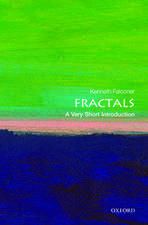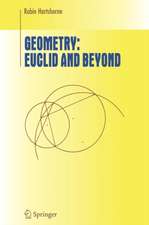Fractals in Science: An Introductory Course
Autor Eugene Stanley, Edwin Tayloren Limba Engleză Paperback – 12 aug 1994
Preț: 397.76 lei
Nou
Puncte Express: 597
Preț estimativ în valută:
76.14€ • 82.73$ • 63.100£
76.14€ • 82.73$ • 63.100£
Carte tipărită la comandă
Livrare economică 21 aprilie-05 mai
Preluare comenzi: 021 569.72.76
Specificații
ISBN-13: 9780387943619
ISBN-10: 0387943617
Pagini: 320
Ilustrații: 320 p.
Dimensiuni: 203 x 254 x 17 mm
Greutate: 0.64 kg
Ediția:Softcover reprint of the original 1st ed. 1994
Editura: Springer
Colecția Springer
Locul publicării:New York, NY, United States
ISBN-10: 0387943617
Pagini: 320
Ilustrații: 320 p.
Dimensiuni: 203 x 254 x 17 mm
Greutate: 0.64 kg
Ediția:Softcover reprint of the original 1st ed. 1994
Editura: Springer
Colecția Springer
Locul publicării:New York, NY, United States
Public țintă
Lower undergraduateCuprins
1. From Coin Flipping to Motion of Molecules.- 1.1 Introduction.- 1.2. Randomness: Making Predictions Even When No One Knows What Will Happen Next.- 1.3. How Often Something Happens (Probability Distributions).- 1.4 Random Movement (Random Walks).- 1.5 Pascal’s Triangle.- 1.6 Average Displacement and Average Squared Displacement.- 1.7 Diffusion.- 1.8 Periodic Precipitation: Liesegang Rings.- 1.9 Postlude: The Meaning of Models.- Appendix A Demonstration that Average Squared Displacement Is Equal to Number of Steps Taken.- Appendix B. Preparation for Liesegang Ring Experiment.- 2. Fractals in Nature. Growing and Measuring Random Fractals.- 2.1 Introduction.- 2.2. Coastline.- 2.3. The Meaning of Dimension.- 2.4. Growing Random Patterns.- 2.5. Computer Measurement of Fractal Dimension.- 2.6. Modeling the Growth of a Fractal Pattern.- 2.7. The Hele-Shaw Experiment.- 2.8 Branching Patterns Formed by Bacterial Colonies.- 2.9 Termite Nesting and Foraging in Two Dimensions.- 2.10 Fractal Root Systems.- 2.11. Research!.- Appendix A. Dimensions and Logarithms.- Appendix B. Construction of ECD and Hele-Shaw Cells.- Appendix C. Using Video Frame Grabbing.- Appendix D. Using the Scanner for Imaging.- Appendix E. Preparing the Carrageenan Solutions.- Appendix F. Using the Vernier pH Meter.- Appendix G. Preparation of Bacterial Growth Experiment.- Appendix H. Constructing the Cell for a Termite Colony.- Appendix I. Constructing Rhizotron for Root Systems.- 3. Growth Patterns in Nature: Percolation.- 3.1 Growing a Forest.- 3.2 Burning a Forest.- 4 DNA and Literature.- 4.1 DNA Sequences.- 4.2 Storing Information in DNA.- 4.3 Word Occurences and Zipf’s Law.- 4.4 Landscapes of Literature and DNA.- 4.5 Discover coding regions in DNA.- A Answers to problems..- B Log-Log-paper.- C Thisand That.- 5 Spin Glasses and Neural Networks.- 5.1 Introduction.- 5.2 Magnetic Order.- 5.3 Ising Model.- 5.4 Magnetic Disorder.- 5.5 Spin Glasses.- 5.6 Hopfield Model.- 5.7 Bibliography.- 6 Lightning and Soap Films.- 6.1 Introduction.- 6.2 Electric Field.- 6.3 Electrostatics.- 6.4 Laplace Equation.- 6.5 Numerical Approach to our Main Task.- 6.6 Fractal Growth.- 6.7 Bibliography.- 7 Analyzing Rough Surfaces Digitally.- 7.1 Introduction.- 7.2 Defining the Self-Affine Surface.- 7.3 Activity: The Paper Tear Experiment.- 7.4 The Paper Tear: Understanding Experiments with Models.- 7.5 Testing the Minimal Energy Model.- 7.6 Conclusion.

















